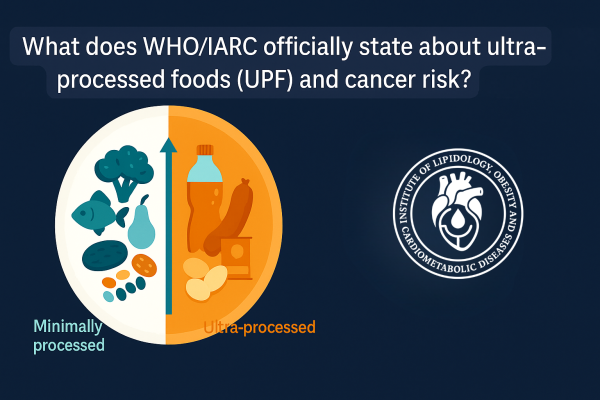Key take-aways
-
On 6 November 2025, the World Health Organization (WHO) announced the composition of a Guideline Development Group and opened public comments until 30 November 2025 for the development of global recommendations on UPF consumption.
-
Large European cohort analyses (EPIC) and recent International Agency for Research on Cancer (IARC) updates (2023–2025) show that higher UPF intake is associated with increased overall mortality and higher risk of multimorbidity (combination of cancer and cardiometabolic diseases).
-
IARC classifies processed meat as Group 1: carcinogenic to humans; every 50 g/day is associated with an approx. 18 % relative increase in colorectal cancer risk. Red meat is classified Group 2A: probably carcinogenic.
-
A recent randomized trial in Nature Medicine (2025) found that a minimally processed diet led to greater weight loss compared with a UPF-rich diet — even when macro- and micronutrient targets were met.
What is UPF?
In most scientific work, UPF is defined by the NOVA system as industrial formulations made from multiple ingredients (often including sweeteners, emulsifiers, colourants, etc.), designed to be convenient, hyper-palatable and long-lasting. Regulatory bodies (for example the UK Food Standards Agency) note that there is no universal legal definition of UPF to date.
What’s new from WHO in 2025
-
On 6 November 2025, WHO published the membership of the Guideline Development Group (GDG) for UPF, and opened public comment submission until 30 November 2025. This marks the official start of drafting the global recommendations on UPF consumption.
Latest evidence (2023–2025)
Mortality and multimorbidity
• EPIC (9 European countries, 2025): higher UPF → higher all-cause mortality, cardiovascular, cerebrovascular, ischaemic heart disease, digestive diseases, and even Parkinson-type syndromes; the effect was independent of alcohol use. Replacing some UPF with minimally processed foods was linked to lower risk.
• EPIC (2023): high UPF intake was linked to greater risk of multimorbidity (cancer + cardiometabolic disease). The strongest associations were seen for processed meats and sugar-sweetened beverages.
Meat classification by IARC
• Processed meat → Group 1 (carcinogenic): ~18 % higher relative risk of colorectal cancer per 50 g/day.
• Red meat → Group 2A (probably carcinogenic). Importantly — this is a risk-level finding, not a statement that cancer is inevitable; risk increases with dose.
Randomised interventions
• Nature Medicine (RCT, 2025): in an 8-week crossover design comparing a minimally processed diet versus a UPF-rich diet under “healthy plate” national guidance, the minimally processed arm achieved greater weight loss. Authors concluded that the degree of food processing matters, independently of macro- and micronutrient composition.
Sweeteners: contextual note
• Aspartame (2023): IARC rated it Group 2B (“possibly carcinogenic”), while the WHO/FAO Joint FAO/WHO Expert Committee on Food Additives (JECFA) confirmed an ADI of 40 mg/kg bw/day. This is a case of hazard evaluation (IARC) and risk assessment (JECFA) complementing each other.
Practical take-aways (LOCD Institute)
These are temporary guidance based on current evidence; they do not replace upcoming WHO recommendations on UPF.
-
Reduce UPF share in your diet, especially processed meats (sausages, bacon, hot dogs), sugar-sweetened drinks and sweet snack products.
-
Replace UPF: every 10 % of energy shifted from UPF to minimally processed foods (vegetables, fruits, legumes, whole grains, fish) is associated with reduced risk.
-
Meat: minimise processed meat; consume red meat less often and in smaller portions; prefer poultry, fish and legumes.
-
Read labels: long ingredient lists and numerous “cosmetic” additives (colourants, flavour enhancers, emulsifiers, sweeteners) are typical UPF markers.
-
Whole-food diet: make whole foods and home/fresh cooking your base — this correlates with better long-term outcomes.
This material is for educational purposes and does not substitute personal medical advice. The LOCD Institute position is aligned with evidence-based medicine and will be updated following the publication of official WHO guidelines on UPF.
